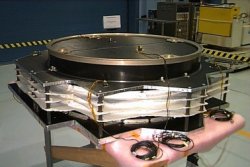Whipple shield

Whipple shield used on Stardust probe.
A Whipple shield is a thin shield, also known as a meteor deflection screen, that protects a spacecraft from damage due to collision with hypervelocity micrometeoroids and other fast-moving minor debris. It is named after Fred Whipple who first suggested it in 1946 and referred to it as a "meteor bumper".
Whipple shields are based on the principle that small meteoroids explode when they strike a solid surface; therefore if a spacecraft is protected by an outer skin about a tenth of the thickness of its main skin, an impinging body will be destroyed before it cause any real damage. The simplest kind of Whipple shield consists of a bumper, such as a thin sheet of aluminum, and a standoff, or open space, between the bumper and the wall of the spacecraft to allow any remaining fragments that make it past the bumper to spread out. Over the years, many different types of Whipple shield have been designed. The International Space Station alone uses 200 different types of Whipple shield to protect it from impacts.
Stuffed Whipple shield
The stuffed Whipple shield is a variation of the simple Whipple shield in which layers of Nextel (a woven ceramic fabric) and Kevlar are inserted between the bumper and the rear wall. These additional layers further shock and pulverize the debris cloud so that that any fragments reaching the rear wall are harmless.
Multi-shock shield
The multi-shock shield is a popular shielding design that consists of staggering layers of Nextel at specified standoff distances. The multiple layers of Nextel repeatedly shock the projectile and debris cloud until the remaining fragments have too little energy to breach the rear wall.


